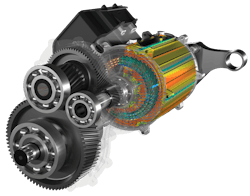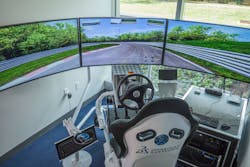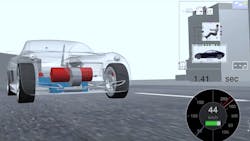Simulation software couples the virtual world with the real world
Dean Palfreyman is senior director, Simulia strategy, at Dassault Systèmes.
What have been the biggest improvements to simulation-software technology in the past five years?
Dean Palfreyman, senior director, Simulia strategy, Dassault Systèmes: Certainly, there have been advances in simulation technology to solve a wide array of complex engineering problems related to advanced materials, structural integrity, electromagnetics, aerodynamics, acoustics and control systems. Additionally, advancements in process automation and optimization technologies make it possible for product-development teams to automate the process of evaluating hundreds or even thousands of design options using design-of-experiments (DOE) applications.
What’s the most innovative or efficient simulation-software technology application you’ve ever seen or been involved with?
Dean Palfreyman, senior director, Simulia strategy, Dassault Systèmes: It’s amazing to see the advancements in real-time simulation of mechanical systems, which enable the rapid evaluation of hardware, software and human-in-the-loop scenarios (Figure 1). This is unique as it enables engineers to model and couple the virtual world with the real world. It is enabling the use of driving simulators to evaluate and improve vehicle handling and control systems in response to changing road conditions and driver reactions (Figure 2).
Dean Palfreyman, senior director, Simulia strategy, Dassault Systèmes: If you compare the cars of the 1980s to vehicles today, it’s easy to see the improvements that occurred largely due to advances in computer-aided design and simulation technologies (Figure 4). Moreover, these performance and safety improvements are not just related to cars, but also aircraft, tires, toothbrushes, food packaging and just every product that we are using in our everyday lives.
However, product development and manufacturing organizations are facing ever-increasing challenges, ranging from a distributed workforce to disparate government regulations and sustainability mandates to increasing product complexity and the demand to lower costs and save time by eliminating physical prototypes.
Driver-assisted and autonomous vehicles are prime examples of the complexity and connectivity issues facing manufacturers across all industries. High-tech vehicles and products also require the integration of components and systems provided by suppliers. This added complexity makes it impossible to develop and manufacture in a siloed organization.
The only option is for manufacturers to leverage a platform that enables all stakeholders, including their suppliers, to manage their projects and data, design their products, simulate the functional performance of interdependent components and systems and collaborate on performance-based decisions efficiently and securely.
Dean Palfreyman, senior director, Simulia strategy, Dassault Systèmes: Design and simulation software can be installed on a personal computer or laptop without significant IT knowledge or support. Alternatively, the applications can be accessed through a cloud subscription with no installation or IT support required. Many startups and small- to medium-size businesses are taking advantage of this to minimize their computing hardware and IT infrastructure requirements.
However, large organizations, with high-security requirements or those who are developing complex products across a global team still use their internal IT operations and private networks. Due to this, there will continue to be a need for IT organizations to support networks and software installations. However, third-party cloud offerings are providing alternatives to in-house IT for installing and managing software, which is becoming attractive to many larger businesses who are under pressure to reduce overhead costs.
What future innovations will impact the use of simulation-software technology in manufacturing operations?
Dean Palfreyman, senior director, Simulia strategy, Dassault Systèmes: There are a number of macro-innovations that are affecting the use and benefits of simulation technology. To name a few, artificial-intelligence (AI)/machine-learning (ML) technology is accelerating the process of creating and computing a simulation as well as providing deeper insight into data derived from simulation. The ability to create dynamic surrogate models providing real-time scenario-centric feedback to improve products in operation with a high degree of accuracy. This is particularly important for predictive maintenance. A continuing issue for product development teams is the ability to seamlessly—the operative word—unify their designs and multiple physics together to simulate complex product and system scenarios to gain deeper insight into their product and system behavior.
Dean Palfreyman, senior director, Simulia strategy, Dassault Systèmes: Dassault Systèmes’ 3DExperience platform provides a unified, digital environment that enables manufacturing organizations to leverage applications from Dassault Systèmes’ world-class brands including, among others, Enovia for planning and product lifecycle management, Catia for product design and systems engineering, Simulia for realistic simulation of virtual prototypes and Delmia for planning and simulation of manufacturing facilities and operations.
Global development teams are using the platform and applications to manage their product development lifecycles and collaborate on meeting business and functional requirements from research and concept phases to detailed designs, virtual testing, manufacturing and product retirement.
By bringing people, technology and processes together on the platform, manufacturing organizations are able to accelerate innovation and meet their business and sustainability goals.
Dassault Systèmes’ 3DExperience platform enables our clients to leverage a geometry model to analyze a range of functional performance attributes and share the simulation results to collaborate on performance-based decisions and optimize their designs before committing to a physical prototype. This leads to better outcomes, shorter timelines and lower costs for our customers.
Remote working during the COVID-19 pandemic was a proving ground of the benefits and capabilities of remote connectivity. Dassault Systèmes has a long history of providing networked and on-cloud deployment options, providing our clients with access to our technology and their projects from anywhere, at any time, on any device.
However, remote connectivity is not just about connecting users to their software; it’s also about connecting people to each other. All the required applications and associated data are available on 3DExperience on-cloud to multiple user types, such as designers, industry process specialists, simulation experts, and manufacturing teams so they can collaborate on their projects securely, in real-time and across global time zones.
Dassault Systèmes delivers a virtual twin experience through our 3DExperience platform. A virtual-twin experience lets you visualize, model and simulate sophisticated experiences. Starting with a 3D model that represents the shape, dimensions and properties of a physical product or system, simulations are run on that virtual model to explore how the product will behave when assembled, operated or manufactured.
The 3DExperience platform is built on a data model that combines a description of products' requirements, static and dynamic behaviors, logical and physical models. This drives model-based system engineering of virtual twins at every stage of an object’s life. From regulatory requirements, materials and functional design to manufacturing and the customer’s experience, every stage can be modeled, simulated and manipulated. This capability extends into connecting a virtual twin of the factory with the real shop-floor operations for simulation, optimization and planning maintenance activities.
About the Author
Mike Bacidore
Editor in Chief
Mike Bacidore is chief editor of Control Design and has been an integral part of the Endeavor Business Media editorial team since 2007. Previously, he was editorial director at Hughes Communications and a portfolio manager of the human resources and labor law areas at Wolters Kluwer. Bacidore holds a BA from the University of Illinois and an MBA from Lake Forest Graduate School of Management. He is an award-winning columnist, earning multiple regional and national awards from the American Society of Business Publication Editors. He may be reached at [email protected]

Leaders relevant to this article:






